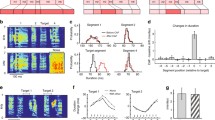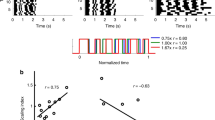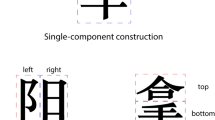Abstract
A neuromotor model of handwritten stroke generation, in which stroke velocities are expressed as a Fourier-style decomposition of oscillatory neural activities, is presented. The neural network architecture consists of an input or stroke-selection layer, an oscillatory layer, and the output layer where stroke velocities are estimated. A separate timing network prepares the network’s initial state, which is crucial for accurate stroke generation. Neurobiological significance of this preparation, and a possible mapping of our architecture onto human motor system is suggested. Interaction between timing network and oscillatory layer closely resembles interaction between Basal Ganglia and Supplementary Motor Area in the brain.
Similar content being viewed by others
References
Ellis, A.W., Modeling the writing process. In: Denes, G., Semenza, C., Bisiacchi, P., Andreewsky, E. (eds.) Perspectives in Cognitive Neuropsychology. Erlbaum, London (1986)
Teulings, H.L., Thomassen, A.J.W.M., Schomaker, L.R.B., Morasso, P.: Experimental protocol for cursive script acquisition: the use of motor information for the automatic recognition of cursive script. In: Report 3.1.2., ESPRIT Project, 419 (1986)
Schomaker, L.R.B.: Simulation and recognition of handwriting movements: a vertical approach to modeling human motor behavior. Ph.D. Thesis, Nijmegen University, Netherlands (1991)
Plamondon R. (1989). An evaluation of motor models of handwriting. IEEE Trans. Syst. Man Cybern. 19(5): 1060–1072
Grossberg S. and Paine R.W. (2000). A neural model of corticocerebellar interactions during attentive imitation and predictive learning of sequential handwriting movements. Neural Netw. 13: 999–1046
Hollerbach J.M. (1981). An oscillation theory of handwriting. Biol. Cybern. 156(39): 139
Kalveram, K.Th.: A neural oscillator model learning given trajectories, or how an allo-imitation algorithm can be implemented into a motor controller. In: Piek, J. (ed) Motor Control and Human Skill: A Multi-disciplinary Perspective. Human Kinetics, Champaign (1998)
Galen G.V. and Weber J. (1998). On-line size control in handwriting demonstrates the continuous nature of motor programs. Acta Psychol. 100: 195–216
Bullock, D., Grossberg, S.: The VITE: a neural command circuit for generating arm and articulator trajectories. In : Kelso, A., Shlesinger, M.M. (eds) Dynamic Patterns in Complex Systems. World Scientific, Singapore (1988)
Fiala J., Grossberg S. and Bullock D. (1996). Metabotropic glutamate receptor activation in cerebellar Purkinje cells as substrate for adaptive timing of the classically conditioned eye-blink response. J. Neurosci. 16: 3760–3774
Chirikov B. (1979). A universal instability of many—dimensional oscillator systems. Phy. Rev. 52: 263–379
Bressloff, P.C., Coombes, S., Souza, B.: Dynamics of a ring of pulse-coupled oscillators: group theoretic approach. Phys. Rev. E Stat Nonlin Soft Matter Phys 66, (2002)
Haykin, S., Neural Networks: A Comprehensive Foundation, Prentice Hall PTR, Englewood Cliffs (1998)
Latash M.L., Scholz J.F., Danion F. and Schöner G. (2001). Structure of motor variability in marginally redundant multi-finger force production tasks. Exp. Brain Res. 141: 153–165
Marder E. and Calabrese R.L. (1996). Principles of rhythmic motor pattern production. Physiol. Rev. 76: 687–717
Chakravarthy, V.S., Thomas, S.T., Nair, N.: A model for scheduling motor unit recruitment in skeletal muscle. In: Proceedings of International Conference Theoretical Neurobio, Gurgoan (2003)
Kornhuber H.H. and Deecke L. (1990). Readiness for movement—the Bereitschafts potential-story. Curr. Contents Life Sci. 33: 22
Lang W., Cheyne R., Kristeva R., Beistener R., Lindinger G. and Deeke L. (1991). Three dimensional localization of SMA activity preceding voluntary movement: a study of electric and magnetic fields in a patient with inflation of the right supplementary motor area. Exp. Brain Res. 87: 688–695
Georgopoulos A.P., Lurito J.T., Petrides M., Schwartz A.B. and Massey J.T. (1989). Mental rotation of the neuronal population vector. Science 243: 234–236
Kubota K. and Hamada I. (1978). Visual tracking and neuron activity in the post—arcurate area in monkeys. J. Physiol. Paris. 74: 297–312
Kubota K. and Funahashi S. (1982). Neuron activities of monkey prefrontal cortex during the learning of visual discriminations tasks with go/no-go performances. Neurosci. Res. 3: 106–129
Crammond D.J. and Kalaska J.F. (1989). Neuronal activity in primate parietal cortex area 5 varies with intended movement direction during an instructed—delay period. Exp. Brain Res. 76: 458–462
Alexander G.E. (1987). Selective neuronal discharge in monkey putamen reflects intended direction of planned limb movements. Exp. Brain Res. 67: 623–634
Churchland M.M., Yu B.M., Ryu S.I., Santhanam G. and Shenoy K. (2006). Neural variability in premotor cortex provides a signature of motor preparation. J. Neurosci. 26(14): 3697–3712
Tanji J. (1994). The supplementary motor area in the cerebral cortex. Neurosci. Res. 19(3): 251–268
Tanji J., Taniguchi K. and Saga T. (1980). Supplementary motor area: neuronal response to motor instructions. J. Neurophysiol. 43: 60–68
Aizawa H. and Tanji J. (1994). Cortico-cortical and thalamo-cortical responses of neurons in the monkey primary motor cortex and their relation to a trained motor task. J. Neurophysiol. 71: 550–560
Buhusi C.V. and Meck W.H. (2005). What makes us tick? Functional and neural mechanisms of interval timing. Nat. Rev. Neurosci. 6: 755
Matell M.S. and Meck W.H. (2004). Cortico-striatal circuits and interval timing: coincidence detection of oscillatory processes. Cogn. Brain Res. 21: 139–170
Cunnington R., Iansek R., Bradshaw J.A. and Phillips J.G. (1995). Movement-related potentials in Parkinson’s disease. Presence and predictability of temporal and spatial cues. Brain 118: 935–950
Georgiou N., Iansek R., Bradshaw J.L., Phillips J.G. and Mattingley J.B. (1993). An evaluation of the role of internal cues in the pathogenesis of Parkinsonian hypokinesia. Brain 116: 1575–1587
Kao M.H., Doupe A.J. and Brainard M.S. (2005). Contributions of an avian basal ganglia-forebrain circuit to real-time modulation of song. Nature 433(7026): 638–643
Rusu, A., Govindaraju, V.: Handwritten CAPTCHA: using the difference in the abilities of humans and machines in reading handwritten words, IWFHR, pp. 226–231. In: 9th International Workshop on Frontiers in Handwriting Recognition (IWFHR’04) (2004)
Perko L. (2006). Differential Equations and Dynamical. Springer, Heidelberg
Author information
Authors and Affiliations
Corresponding author
Rights and permissions
About this article
Cite this article
Gangadhar, G., Joseph, D. & Chakravarthy, V.S. An oscillatory neuromotor model of handwriting generation. IJDAR 10, 69–84 (2007). https://doi.org/10.1007/s10032-007-0046-0
Received:
Accepted:
Published:
Issue Date:
DOI: https://doi.org/10.1007/s10032-007-0046-0




